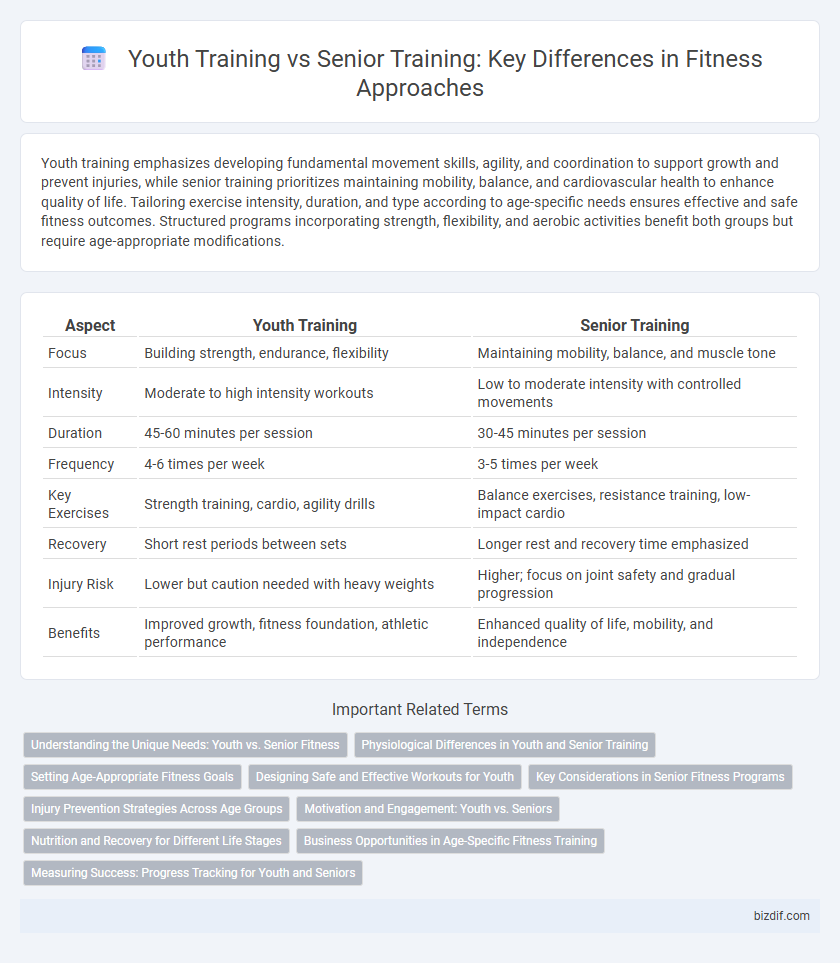Youth training emphasizes developing fundamental movement skills, agility, and coordination to support growth and prevent injuries, while senior training prioritizes maintaining mobility, balance, and cardiovascular health to enhance quality of life. Tailoring exercise intensity, duration, and type according to age-specific needs ensures effective and safe fitness outcomes. Structured programs incorporating strength, flexibility, and aerobic activities benefit both groups but require age-appropriate modifications.
Table of Comparison
| Aspect | Youth Training | Senior Training |
|---|---|---|
| Focus | Building strength, endurance, flexibility | Maintaining mobility, balance, and muscle tone |
| Intensity | Moderate to high intensity workouts | Low to moderate intensity with controlled movements |
| Duration | 45-60 minutes per session | 30-45 minutes per session |
| Frequency | 4-6 times per week | 3-5 times per week |
| Key Exercises | Strength training, cardio, agility drills | Balance exercises, resistance training, low-impact cardio |
| Recovery | Short rest periods between sets | Longer rest and recovery time emphasized |
| Injury Risk | Lower but caution needed with heavy weights | Higher; focus on joint safety and gradual progression |
| Benefits | Improved growth, fitness foundation, athletic performance | Enhanced quality of life, mobility, and independence |
Understanding the Unique Needs: Youth vs. Senior Fitness
Youth training emphasizes developing strength, agility, and coordination through dynamic, high-intensity workouts that support growth and motor skill acquisition. Senior training focuses on maintaining mobility, balance, and functional strength with low-impact exercises tailored to prevent injury and manage age-related conditions such as arthritis or osteoporosis. Both approaches require customized programs that address specific physiological changes and fitness goals unique to each age group.
Physiological Differences in Youth and Senior Training
Youth training emphasizes rapid muscle growth, higher metabolic rate, and enhanced neural plasticity, enabling quicker recovery and adaptation to physical stress. Senior training focuses on maintaining muscle mass, improving joint mobility, and enhancing cardiovascular health due to age-related declines in muscle mass (sarcopenia) and bone density. Tailoring exercise intensity and recovery periods to these physiological differences optimizes performance and reduces injury risk across age groups.
Setting Age-Appropriate Fitness Goals
Setting age-appropriate fitness goals requires consideration of physiological differences between youth and seniors, including growth stages and recovery rates. Youth training emphasizes skill development, coordination, and gradual intensity increases, while senior training focuses on maintaining mobility, strength, and preventing injury through low-impact exercises. Tailoring programs to these distinct needs optimizes health benefits and reduces the risk of overtraining or injury in both age groups.
Designing Safe and Effective Workouts for Youth
Designing safe and effective workouts for youth involves prioritizing proper technique, low-impact exercises, and age-appropriate intensity to prevent injury and promote healthy development. Emphasizing bodyweight movements, flexibility, and coordination helps build a strong foundation while avoiding excessive strain on growing joints and muscles. Structured youth fitness programs should incorporate progressive resistance training and regular monitoring to ensure optimal physical and cognitive growth.
Key Considerations in Senior Fitness Programs
Senior fitness programs prioritize low-impact exercises to reduce joint strain while enhancing mobility and balance, crucial for preventing falls and improving overall quality of life. Customized strength training incorporates lighter weights and longer recovery periods to accommodate decreased muscle mass and bone density typical in older adults. Monitoring heart rate and ensuring proper warm-up and cool-down phases are essential to maintain cardiovascular safety and injury prevention in senior participants.
Injury Prevention Strategies Across Age Groups
Youth training emphasizes dynamic warm-ups and proper technique to support developing musculoskeletal structures, reducing risks of growth plate injuries and overuse syndromes. Senior training prioritizes low-impact exercises, balance improvement, and joint mobility to prevent falls and degenerative conditions like osteoarthritis. Tailoring injury prevention strategies to age-specific physiological needs enhances overall safety and long-term fitness adherence.
Motivation and Engagement: Youth vs. Seniors
Youth training thrives on dynamic, social environments that boost motivation through peer interaction and gamified challenges, enhancing engagement and sustained interest. Senior training emphasizes personalized goals, functional movements, and positive reinforcement, fostering motivation by highlighting improvements in daily living and overall well-being. Tailoring motivational strategies to age-specific preferences ensures higher adherence and optimal fitness outcomes across both demographics.
Nutrition and Recovery for Different Life Stages
Youth training emphasizes higher protein intake and carbohydrates to support rapid growth and energy demands, alongside shorter recovery periods to accommodate frequent training sessions. Senior training prioritizes nutrient-dense foods rich in calcium, vitamin D, and antioxidants to maintain bone health and reduce inflammation, with extended recovery times allowing for muscle repair and injury prevention. Tailoring nutrition and recovery strategies to life stage-specific physiological needs enhances performance and overall well-being.
Business Opportunities in Age-Specific Fitness Training
Youth training emphasizes agility, growth, and injury prevention, creating business opportunities in sports-specific programs and developmental fitness classes. Senior training focuses on mobility, balance, and chronic disease management, driving demand for tailored rehabilitation and low-impact exercise services. Age-specific fitness training allows businesses to target diverse markets with customized offerings that improve client retention and satisfaction.
Measuring Success: Progress Tracking for Youth and Seniors
Measuring success in youth training emphasizes tracking improvements in coordination, strength, and endurance through age-appropriate fitness tests and performance benchmarks. Senior training progress focuses on monitoring flexibility, balance, cardiovascular health, and functional mobility using tailored assessments like the Senior Fitness Test and regular health screenings. Consistent progress tracking with wearable technology and personalized fitness apps enhances motivation and adapts programs for both youth and seniors to optimize results.
Youth Training vs Senior Training Infographic

 bizdif.com
bizdif.com